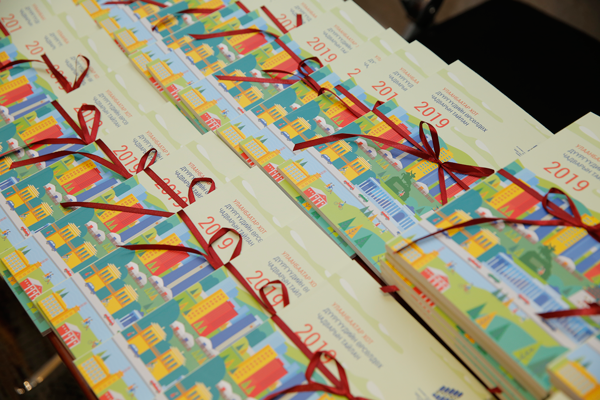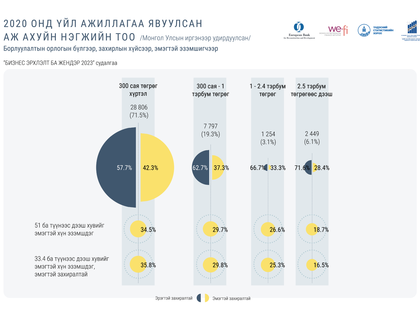Urbanization or overpopulation?

Economic Policy and Competitiveness Research Center (EPCRC) introduced the “District Competitiveness Report 2019” and presented its results.
Urbanization is one of the phenomenons which inevitably occur in the process of a country’s development and it is understood as development, advancement, and renovation. We do not see urbanization as a mere population shift from rural to urban residency. Urbanization is a higher living standard and more opportunities.
In Mongolia, how is this very phenomenon known as urbanization defined and what changes is it bringing? Is urbanization improving people’s lives and helping them to reach their dreams?
Urbanization is a crucial factor in the process of a country’s development. In Mongolia, 67.2% of the total population lives in the urban area and 45.3% or one in every two people lives in the capital city, Ulaanbaatar. Among them, 95.1% of the residents of Ulaanbaatar lives in the central six districts.
The fact that the majority of the population is concentrated in Ulaanbaatar city, which is only 0.3% of the total territory of Mongolia, proves that urbanization is accelerating. However, it is important to define urbanization correctly and measure it realistically and in a multifaceted way, in order to evaluate the effectiveness of the urbanization. It is the main purpose of “Ulaanbaatar City District Competitiveness Report”.
Compared to two years ago, when the study of district competitiveness started, the population of Ulaanbaatar city has increased by 2.7% and reached 1.4 million and 386,000 households.
Ulaanbaatar city's overall competitiveness index is 0.557 points, increased by 7% since the 2017 study. The competitiveness index is graded with 0-1 points, the closer it gets to 1, the better the competitiveness is.

The five main factors of Ulaanbaatar city competitiveness, economic performance, and quality of life indexes show relatively good results with more than 0.6 points. On the other hand, safety and governance indexes are at around 0.5 points and living environment is evaluated with less than 0.5 points.
Without a doubt, the crux of the Mongolian economy is concentrated in Ulaanbaatar city. 64.2% of the total business entities operate in the capital city, constituting to 64.7% of total GDP. According to the result of the district competitiveness report, unemployment rate and price pressure on living standards are still high, even though economic concentration is high also raising people’s expectation towards the changes in the future living standards in Ulaanbaatar. Monthly income of 39% of the households is less than 500,000 MNT.
The main factors which attract people from rural areas to cities, including health services, high-quality education, inner and outer environment of hospitals and schools are better compared to the ones in rural areas. But it can be seen from the report that hospital workload is still heavy regardless of the better quality of health and education services, hospitals and school environment. In addition, even though the secondary school enrollment yielded good results, the kindergarten enrollment rate was insufficient. As of 2017, 78% of children from 2 to 5 attend kindergartens. Also, the pupil-teacher ratio of public kindergartens is high. (The number of students per teacher is 38) Even though the availability of kindergartens and schools is increasing, it is not fast enough to catch the population growth rate.
How safe and the secure city is Ulaanbaatar? In comparison to the number of population, criminal offenses in Ulaanbaatar city is higher than that in rural areas. Also, the criminal offenses increased and the number of crimes solved decreased compared to the study two years ago. However, youth engagement in criminal offenses is in a decreasing trend. Also, respondents evaluated the current legislative system and its fair and equal treatment to everybody with 3.8 points which is a very poor result.
One of the conditions to live safely is to live in a healthy and clean environment. However, the residents of Ulaanbaatar city are not living in a healthy environment. It is proven by the fact that indicators such as air pollution, public littering, and noise pollution received a low evaluation.
One of the main advantages of urbanization is that it creates a convenient living environment. As of now, 44% of the total households in Ulaanbaatar city is living in apartments with centralized and independent engineering system and 27% of them live in Mongolian traditional gers. Most interestingly, this indicator has not changed much since 10 years ago. (26% of the total households lived in Mongolian traditional ger in 2007 )
Respondents provided a middle rating to optimality of city planning. The fact that indicators such as green space, children’s playground, and pedestrian road yielded insufficient results, influenced the evaluation.
Compared to the previous study’s results, accessibility of activities from khoroo and districts has improved, following the advancement in khoroo and districts’ e-governance and information transparency. However, citizens' participation in the budget process is still low.
Thus, from one side, urbanization is accelerating as the population of the city and its density increase. However, in terms of quality of urbanization, the reality doesn’t match how it should ideally be, the living standard should not decrease depending on the population density and opportunity to choose should not be limited.
It is true that urbanization creates opportunities for people to have better living standards. However, it is not inclusive enough. It concludes that the main issues which have to be considered are to expand the positive impacts of urbanization and develop competitiveness sustainably in the long term.
Three levels can be developed based on differences between the competitiveness of each district. These are: districts which have relatively high competitiveness such as Khan-Uul, Bayangol and Bayanzurkh (competitiveness indexes are more than 0.510), districts which have average competitiveness such as Chingeltei, Sukhbaatar, Songinokhairkhan (competitiveness indexes are between 0.46-0.51), and remote districts such as Baganuur, Nalaikh, Bagakhangai (competitiveness indexes are less than 0.46).
In other words, it can be said that the competitiveness of districts is distinct from one another.
Overall district competitiveness index

In order to improve the competitiveness of Ulaanbaatar city and eradicate the competitiveness differences of districts, it is necessary to conduct the research and report the results regularly and focus more on the weaknesses of the indicators.
We want a city, full of opportunities for everyone to live fulfilled and satisfied life, not a city full of problems due to population concentration.
 English
English




